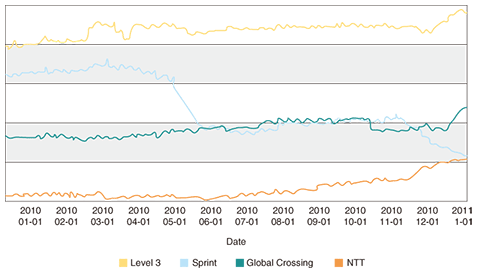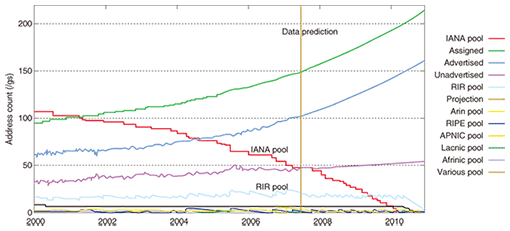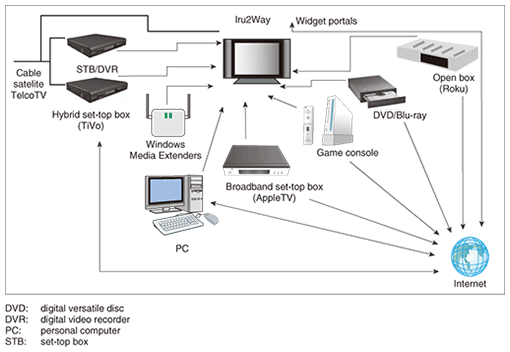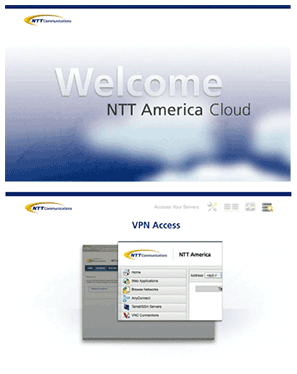 |
|||||||
|
|
|||||||
|
NTT around the World Vol. 9, No. 4, pp. 63–68, Apr. 2011. https://doi.org/10.53829/ntr201104ov1  NTT America—
|
|||||||
| † | NTT America 101 Park Avenue, 41st Floor, New York, NY 10178 USA |
|---|
1. Overview of NTT America
NTT America, the U.S. subsidiary of NTT Communications (NTT Com), is headquartered in New York. The Chief Executive Officer is Kazuhiro Gomi, who was appointed in June 2010. The 600+ strong workforce supports the three primary business divisions.
NTT America’s private network services are grouped under Arcstar™, the brand name that is fast becoming synonymous with advanced telecommunications technology and superior service. With its leased-line services, IP-VPN (Internet protocol virtual private network), and MPLS (multiprotocol label switching) network access, Arcstar is leading the way for multinational corporate sales. The Arcstar sales team targets both Japanese companies doing business in the USA and U.S. companies expanding their networks to Asia with comprehensive support services conducted in both English and Japanese. With NTT Com’s purchase of Pacific Crossing, owners of the PC-1 transpacific submarine cable system, NTT America now has two of the most attractive low-latency routes targeted at the financial services segment: New York to Tokyo and Chicago to Tokyo.
NTT Com’s Global IP Network (or GIN, as it is known inside NTT Com) owns and operates a Tier-1 IP network that is one of the largest Internet backbones in the world. Driven by financially backed service level agreements (SLAs), secure networking and managed VPNs, reliable content distribution capability via Smart Content Delivery™, and NTT Com’s award-winning commercial implementation of IPv6 (Internet protocol version 6), the GIN team targets Internet service providers, web hosting providers, content providers, broadband providers, and large enterprises throughout North, Central, and South America. Known for its rapid provisioning of new customers and excellent customer support in both English and Spanish, the U.S. GIN team is a segment leader. Renesys Corporation*1, the leading network operator research firm, recently noted that GIN had risen to fourth place among global operators. Soon after that report, GIN took over third place from Sprint. NTT America’s Enterprise Hosting services leverage the company’s strong customer care and engineering quality to provide application hosting, collaborative messaging, colocation, managed hosting, private and public cloud computing, and a range of managed services from five company-owned datacenters in the USA. The Gartner Group recently added NTT Com to the web hosting and cloud computing Magic Quadrant*2, noting that “NTT has a global carrier’s breadth of product portfolio, and it is willing to take on highly customized engagements. NTT executes well in its target deal profile—large, complex and customized, for a global customer with needs spanning multiple data centers in different regions.” With brand-name clients like Twitter, the Enterprise Hosting sales teams target social media and gaming companies, Web 2.0, media and entertainment, systems integrators, information technology (IT) consulting businesses, e-commerce, and enterprise customers in North and South America (Fig. 1).

Fig. 1. First cluster (providers 1–4).
| *1 | Renesys Corporation, “A Baker’s Dozen, 2010 Edition.” http://bit.ly/gHZiCK |
| *2 | Gartner Group, “Magic Quadrant for Cloud Infrastructure as a Service and Web Hosting.” http://bit.ly/fwL9vs |
2. Technical trends seen by NTT America’s CTO
From the Office of the CTO, it’s a front-seat view of the technology trends in the USA and abroad. NTT America benefits from the increased use of networking and hosting services, which are the key components for Internet and data-intensive communications. Below are a few noteworthy U.S. trends.
2.1 Mobility and wireless
There is a proliferation of smartphones in the USA driven by the iPhone and Android phones. Broadband access, which was once limited to homes and offices, is fully available on the go at 3G (third generation) speeds, and in some cases the higher speeds offered by LTE (Long Term Evolution). As more people have Internet-connected devices as constant companions, the amount of time they spend using applications, browsing, and downloading video continues to increase. This is great news for network access and hosting providers like NTT America.
2.2 Exponential growth in connected devices
With Wi-Fi, 3G, Ethernet, and other forms of Internet access becoming increasingly available, the number of connected devices is growing exponentially. In homes, it’s not uncommon to see smartphones, laptops, personal computers, gaming consoles, media centers, handheld devices, tablets, and other devices all using the home’s broadband connection. It’s no wonder that the number of IPv4 addresses is rapidly becoming depleted. On February 1, 2011, IANA (Internet Assigned Numbers Authority) allocated the final /8 blocks of IPv4 addresses to the Regional Internet Registries (RIRs). While it will take some time before all of those addresses are used, the available addresses will soon be gone (Fig. 2).

Fig. 2. Address consumption model.
2.3 100-Gigabit/s Ethernet
At the end of the day, data networking is the backbone of a wired world. Whether they use submarine or terrestrial cable systems, networks utilize fiber optics to transmit their data, and network sizes keep on growing. After years of 70% annual growth rates, GIN grew by more than 100% in 2010. Currently, GIN’s solution is to bundle 10GbE (10 Gigabit Ethernet) connections, but this won’t scale much longer. Today, we need about 100 10G edge ports per point of presence (PoP). By the end of 2011, we will require about 200 10G edge ports per PoP, with most of those ports in large link aggregation bundles. Network operators, like GIN, must move to routers that support 100-Gbit/s port connections sooner rather than later. The issue of cost is paramount, and equipment must become relatively affordable (at about 8–10 times 10GbE pricing) and offer routers with 400–500 Gbit/s per slot.
2.4 IPv6
With the proliferation of connected devices, IPv6 was devised as the next-generation network protocol to provide IP addressing to usher the Internet through its next phase of growth. The ability to give each device an IP address, coupled with built-in IPSEC, (IP security) network self-discovery, and a host of other features will open up endless new possibilities. For network operators or enterprises operating large networks, it will be possible to obtain address blocks for contiguous addressing of devices.
2.5 Cloud computing and virtualization
The Internet has become the de facto media transmission network for news and movie distribution, television broadcasting, ebooks, music, etc. The datacenters hosting these data types must be highly connected and highly available so that users can maintain constant access.
From Facebook apps to Salesforce.com, a multitude of server-based systems were deployed in 2010 and will be deployed in 2011 and beyond. The cost savings, resiliency and uptime, service level guarantees, and the ability to let a business focus on its core strengths and not the technology are just a few of the key reasons why and how cloud computing is making a fundamental impact on server deployment (Figs. 3 and 4).

Fig. 3. Networks in the Cloud.

Fig. 4. NTT America Cloud video.
2.6 Social networking
The global importance of social networking almost goes without saying. With 25 billion tweets in 2010, Twitter grew by 100 million users. Facebook now claims over 600 million users (out of 2 billion Internet users, or 30%), had 36 billion photos uploaded to its server last year, and has an estimated market capitalization of US$50 billion. We’ve seen only the tip of the iceberg in this segment.
2.7 High-frequency trading
High-frequency trading and algorithmic trading have dominated the world’s stock, commodity, and currency trading systems, accounting for, at times, up to 70% of the volume. In these applications, highly advanced computer systems can receive data, analyze it, and execute trades in a matter of milliseconds. As such, the latency in the networks between the computer systems and exchanges is of critical importance. Financial firms are willing to pay premium prices for network access that can produce the lowest latency or shave milliseconds off their current latency. Such time differences translate into huge profits for the traders.
2.8 Greening of datacenters
Datacenters consume massive amounts of electricity, sometimes up to megawatts at each installation. Because of their drain on the electrical grid, rising costs of fossil fuels, and unending demand, intense scrutiny must be placed on the efficient use of electricity by datacenter operators. Some tactics might be as simple as using air curtains to separate and direct the flows of cold and hot air. Other tactics could be more complicated but pay huge dividends. These include the use of solid oxide fuel cells, which can convert natural gas or even methane gas, and produce electricity onsite (Fig. 5). The technological development of super-high-efficiency computer room air-conditioning systems, combined with temperature sensors linked to server utilization monitors, can offer significant savings while not wasting precious resources.

Fig. 5. 100-kw solid oxide fuel cell at a datacenter.
3. Activities of the CTO
As the CTO for NTT America, I see across the entire company’s technology portfolio and into many different areas on the business side.
On the business side, I represent technology leadership for the company, and I am utilized in press and media relations on a regular basis. This can be as simple as providing a quote for a press release, giving media interviews for industry journals, or leading panels and presentations at industry conferences, including speaking at the Ethernet Expo event in New York, the CTO Telecom Summit, FutureNet, and the Consumer Electronics Show—a Digital Hollywood event in Las Vegas.
The technology side of my job is what I like most, as I’m a trained electrical engineer. I spend a lot of time on vendor management, not only to control the cost of the components that we purchase, but also to understand the vendor’s technology roadmaps and how they might fit with our product roadmaps and customer responsibilities. I also act as a bridge between the IT department and OSS (operations support systems) development teams to ensure that they are fully aligned with one another. We are making significant efforts to improve our automation systems in 2011 and are actively exporting our systems to other NTT Com affiliates. We are leveraging those relationships in 2011 to understand the technological capabilities of other parts of NTT and how we can leverage those capabilities to strengthen the solutions we bring to our customers, such as developing services for carriers in emerging markets in South America by leveraging the technology that NTT uses to manage consumer networks in Japan. Lastly, I see myself as the advocate for the many technologies that we have developed here at NTT America. There are three examples I’d like to share.
1) GNOME
GNOME is used for operational management and monitoring of network connections and assets. It is being used by both NTT Com in Japan and NTT Europe to manage GIN customer information.
2) GMP
GMP is another OSS system developed to help manage the hosting line of business. It is one of the cornerstones of the Global Virtualization Service, which is poised to offer unprecedented cloud computing services on a global scale.
3) ConfigTools
By operating a network of such size and scale, we realized as long ago as 1997 that we needed to have a way to upload new system images, configurations, and changes to our backbone routers while eliminating any possibility for human error. From this requirement, we developed ConfigTools, which is now the system used NTT-wide for making router changes in GIN.
Comment from NTT America
After the devastating earthquake and tsunami in the northeast part of Japan on March 11, 2011, many non-profit organizations in New York established special funds to aid victims and help the disaster recovery effort. NTT America has already made a donation to the special fund sponsored by the Japanese Chamber of Commerce in New York.
On March 17th, hundreds of Japanese residents in New York gathered in Union Square, the central part of Manhattan, to collect funds and spread awareness for Japan’s ongoing recovery from earthquakes and tsunamis. Families and other groups wore white and red T-shirts with slogans like “Japanese United” to collect checks and small cash donations for organizations.
When I walk in front of Grand Central Station, the largest train station in the USA, I see several small grass-roots groups in front of the station building and hear calls for help. In response to that, many New Yorkers pull bills or coins from their purses and put them in the bokin-bako (donation box). It seems to me that New Yorkers usually have little interest in foreign affairs outside the USA, but for this devastating event they may want to make some contributions to the people in Japan.
Moreover, through word-of-mouth communication in New York’s Japanese communities and through Twitter and Facebook, some grass-roots charity events will be held in New York such as auctions of paintings, 12-hour music concerts performed by famous musicians, sake-tasting events, and charity marathons in Central Park.
When I send email to my colleagues across the USA for various projects, they always ask if my family and relatives in Japan are okay before getting down to business. NTT America has offices in various locations in the USA such as Virginia, Chicago, Dallas, Denver, Seattle, San Jose, and New York, but most of the American workers respond in the same way. For that, I am deeply grateful.
Finally, my colleagues and I would like to express our profound sympathy to the victims of the 2011 Tohoku earthquake and tsunami and offer our deepest condolences to their families and friends. We sincerely hope that the afflicted areas can recover quickly.
Satoru Fujimoto, NTT America








